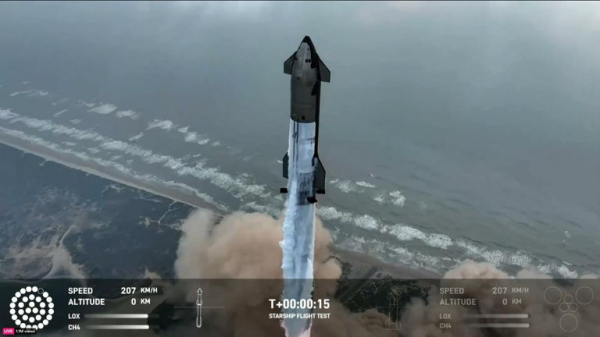
Space X’s Starship has splashed down for a “soft landing” in the Indian Ocean – a success after previous attempts ended in spectacular explosions.
Elon Musk‘s company upgraded software and made other changes for this fourth attempt, which blasted off from Texas for a half lap around the planet.
The billionaire posted on social media: “Despite loss of many tiles and a damaged flap, Starship made it all the way to a soft landing in the ocean!”

X This content is provided by X, which may be using cookies and other technologies. To show you this content, we need your permission to use cookies. You can use the buttons below to amend your preferences to enable X cookies or to allow those cookies just once. You can change your settings at any time via the Privacy Options. Unfortunately we have been unable to verify if you have consented to X cookies. To view this content you can use the button below to allow X cookies for this session only. Enable Cookies Allow Cookies Once
Starship is the world’s largest and most powerful rocket at nearly 400ft (121m) tall.
The first-stage ‘Super Heavy’ booster successfully detached and landed in the Gulf of Mexico three minutes after lift off of the unmanned test.
Starship then fired up its own engines for a flight around the globe.
About an hour later, it began its crucial re-entry into Earth’s atmosphere: this time there was no catastrophic failure, as occurred at this point in March, and it landed in the sea as planned.

Mission control in California erupted in cheers as the team finally achieved its goal.
Each of the previous tests had made it further in terms of SpaceX’s objectives, before either exploding or disintegrating in the atmosphere.
The first rocket exploded minutes after lift-off at a height of about 25 miles (40km) in April 2023.
A second test, in November, made it into space for the first time but also exploded.

The rocket has hundreds of black tiles to protect it against the extreme heat experienced when passing through the Earth’s atmosphere.
The tests are a stepping stone in the firm’s ultimate goal of making Starship reusable, so it’s important to show the descent of the craft and booster can be controlled.
NASA has ordered two Starships for moon-landing missions later this decade and Musk’s company is already selling tourist trips around the moon.
It’s intended to be more powerful and cheaper than SpaceX’s Falcon 9 rocket, which has completed more than 300 launches over the last 14 years.

